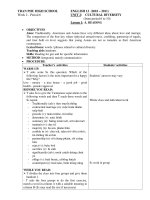Unit 02 cultural diversity (b speaking)
Bạn đang xem bản rút gọn của tài liệu. Xem và tải ngay bản đầy đủ của tài liệu tại đây (2.78 MB, 27 trang )
*
*
*
*
*
Nhóm 3 – Tổ 1:
Nguyễn Thị Phương Hiền
Nguyễn Thị Thu Hà
Trần Doãn Trung Hiếu
Vũ Ngọc Sơn
Nguyễn Hữu Ngọc
CULTURAL DIVERSITY
TASK 1
Activity : Some useful expressions to express the points of
view.
• + I think / feel / believe……………..
• + In my opinion / In my point of view / As far as I am
concerned / For me………………
• + I agree / I don’t agree / It’s not true because……….
• + Perhaps you are right, but………/ I think it’s wrong
to………..
• + I don’t really have any strong opinions
about……………
• + Shall we come back to that later?
Task 2:
Question: What are we talking about
today?
You know, people of different cultures
have different belief and concepts of
happiness. Today, we’ll get to talk
about the differences and the
similarities among cultures of some
countries in the world.
Models:
• What I already know:
- In Britain, “a black cat runs across” means good luck.
- In China, All the brides find it bad luck to look into a mirror on the
Wedding Day.
- In France, a fox brings you good luck.
- In Vietnam, People find it’s good luck when it starts to rain on the
Wedding Day because the couple will be rich.
• What I want to know:
- What creature brings American good luck? And bad luck?
- Is it good or bad luck when someone sneeze once in your
country? (in Vietnam, in The USA, in France etc……)
* What I learned:
- I have learned some typical cultural features from these
countries.
- I have learned the cultural diversity among countries in the world
TASK 2
In pairs, students make some
situations, using useful
expressions given above.
Task 1:
Presentation Criteria
Develop a class viewpoint presentation about the
following ideas, using useful expressions given
above. (Group work)
1) In Vietnam, three or even four generations
may live in a home.
2) A happy marriage should be based on love.
3) In some Asian countries, love is supposed to
follow marriage, not precede it.
4) In some countries, a man and a woman may
hold hands and kiss each other in public.
Activity 2
DISCUSSION
(Pairwork)
Task 2: Below are some typical features of American culture. Work in
pairs, discuss and find out the corresponding features of Vietnamese
Culture.
In America
1) Two generations (parents and
children) live in a home.
2) Old-aged parents live in
nursing homes.
3) It is not polite to ask questions
about age, marriage and income.
4) Americans can greet anyone
in the family first.
5) Groceries are bought once a
week.
6) Christmas and New Year
holidays are the most important.
7) Children sleep in their own
bedrooms.
In Vietnam
1.
In America
Two
generations
live in a
home
Four
generations
live in a
Vietnames
home
2
.
In America, Old-aged
parents live in nursing
homes
In Vietnam,
Elders live and
are taken care by
their children
3
.
Asking about
age, marriage
and salary
In
America
In
Vietnam
4
.
In America
In Vietnam
Greet the head of
the family or an
Everyone can be first older person first,
then the young
ones
6.
The most important
holiday in American
and Vietnam
Christmas & New
Year holiday
Tet holiday
7
.
Children sleep in
their own
bedrooms in
America
Vietnamese
young children
often sleep with
their parents.
Task 2: Below are some typical features of American culture. Work in
pairs, discuss and find out the corresponding features of Vietnamese
Culture.
In America
1) Two generations (parents and
children) live in a home.
2) Old-aged parents live in
nursing homes.
3) It is not polite to ask
questions about age, marriage
and income.
4) Americans can greet anyone
in the family first.
5) Groceries are bought once a
week.
6) Christmas and New Year
holidays are the most
important.
7) Children sleep in their own
bedrooms.
In Vietnam
1) Three or sometimes four
generations live under the same
roof.
2) Elders live with children and are
taken care by their son,
daughters-in-law or daughters.
3) Asking about age, marriage and
salary are acceptable.
4) A Vietnamese greets the head
of the family or an older person
first, then the young ones.
5) The Vietnamese celebrate dead
days. They prepare the meals and
often invite their relatives and
friends to get together and talk
about good respect of the dead
person.
6) TET is the most important.
TASK 3
Comparisons
(Group work)
Talk about the similarities and
differences between Vietnamese
and American Cultures, using the
features discussed in Activity 2
American Culture
Vietnamese Culture
1) Most of the Americans are
individualists.
2) People always ask if it’s OK
when they want to smoke.
3) People often kiss friends
on the cheek when they
meet to express
friendliness.
4) Young people usually live
in their own houses or
flats after marriage.
5) Teenager go out on dates a
lot.
6) Asking someone about
his/her age, marriage is
considered to be impolite.
7) People live in nuclear
family.
1) The Vietnamese are
collectivists.
2) Smokers light up cigarettes
at any time without
asking permission.
3) The Vietnamese never
exchange cheek-kisses.
It’s a shock to most
married women.
4) It’s OK to blow your nose in
public.
5) Young people usually live
with their parents after
their marriage.
6) It’s OK to ask people about
their marriage, age,
salary.
7) People live in extended
family.
1) American and Vietnamese people are multi-culture
countries.
2) Both Americans and Vietnamese are friendly,
hospitable and hard-working people who are
always proud of their countries.
3) They both hate war and love peace.
4) They both like doing charity work.
5) .............................................................................
...............
6) .............................................................................
.................
7) .............................................................................
................
8) .............................................................................
...............
Compare and Contrast
Write about the differences
and the similarities between
the Vietnamese and
American Cultures.
Introduction
Differences
Differences
Similarities
Conclusions
Values
Likes,
Dislikes
Lifestyle
Traditional
Foods & Drinks
Character
Custom









